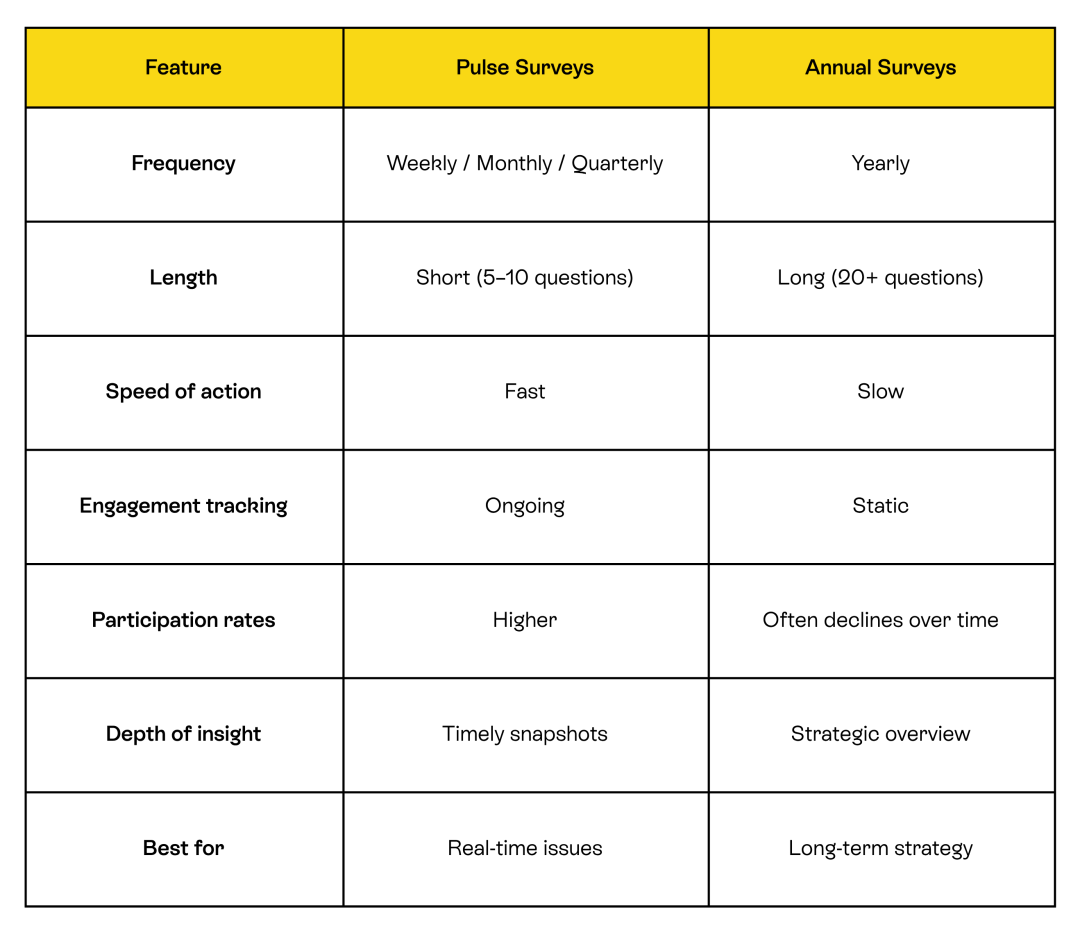Why Survey Segmentation Matters So Much In Employee Feedback
Aggregated data tells you what is happening – but not where or why. Segmentation is the solution!
Read MoreSo, you’re here wondering what’s the better option – pulse surveys or annual engagement surveys?
For years, annual engagement surveys were the go-to.
One big survey, once a year, with questions covering everything from job satisfaction to leadership trust.
But the world of work has moved on.
A once-a-year check-in with 50+ questions just doesn’t cut it anymore.
Don’t get us wrong, annual surveys have a place – but as a stand-alone strategy they simply aren’t enough.
Enter, pulse surveys.
They’re quick, regular surveys that help you stay in tune with how your people are feeling all throughout the year – and they’re the answer to driving real, positive change.
Let’s break it down.

An annual engagement survey is a long-form questionnaire that typically goes out once a year to all employees.
It’s often used to take a deep dive into how people feel about their work, their teams, leadership, and the company as a whole.

A pulse survey is a short, focused survey that’s sent out more regularly – weekly, monthly or quarterly.
Think 5 questions instead of 50.
The aim is to keep a steady ‘pulse’ on how your team is doing and spot issues before they escalate.
At Stribe, our customers use pulse surveys to gather insights on everything from wellbeing and morale to inclusion, recognition and leadership support.
Annual surveys are great for a bird’s-eye view. But real change happens at ground level.
And that’s where pulse surveys are most beneficial.
When feedback is regular, relevant and easy to give, employees are more likely to speak up.
And when feedback is easier to understand and share, leaders are more likely to act.
In a UK report, only 19% of employees said they believe their feedback was acted on – a clear sign that traditional approaches are falling short.
With pulse surveys, the feedback loop is shorter – listen, understand, act.

Each survey types have their place, it all depends on your goals.
For many small to mid-sized UK businesses, a pulse-first approach is more practical.
It gives you more control, better engagement, and fewer delays.
That’s why so many Stribe customers are ditching old-school surveys in favour of a more human approach.
With Stribe, you don’t have to choose between strategy and agility, because you get both.
Our employee engagement platform is built for busy HR and people teams who want to:
We believe every employee should feel heard, and people manager should feel empowered to make things better.
About the author

Starting out her early career as a journalist, Jade Madeley is an accomplished content writer with 8+ years’ experience across business, personal finance, SaaS, human resources and employee engagement. Working with Stribe, she crafts insightful content that brings complex HR topics to life and drives meaningful action.
Aggregated data tells you what is happening – but not where or why. Segmentation is the solution!
Read MoreIf your organisation has been through failed surveys in the past, you might already be feeling the effects. Learn how to turn it all around.
Read MorePractical tips for getting employees to finally read your HR policies, plus how Stribe’s Employee Intranet can multiply your chances of success.
Read More